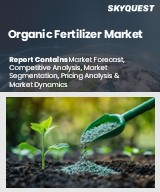
유기 비료 세계 시장 규모는 2023년 122억 달러로 평가되었고 예측 기간(2025-2032년) CAGR은 6.8%로, 2024년 130억 3,000만 달러에서 2032년에는 220억 5,000만 달러로 성장할 전망입니다.
세계 유기질 비료 시장은 지속 가능한 농업 관행과 친환경 농업 솔루션에 대한 수요 증가로 인해 강력한 성장세를 보이고 있습니다. 이러한 추세를 주도하는 주요 요인으로는 화학비료가 토양 건강과 작물 품질에 미치는 악영향에 대한 인식이 높아진 것을 들 수 있습니다. 소비자들은 유기농 농산물을 선택하고, 농부들은 토양 비옥도를 높이고 지속 가능한 농법을 촉진하는 유기농 대안을 찾고 있습니다. 다양한 지역에서 유기농업이 확대되고 있으며, 환경의 지속가능성을 지원하는 정부의 이니셔티브와 함께 시장의 잠재력은 더욱 커지고 있습니다. 또한, 유기질 비료 생산 기술의 발전으로 제품의 효능과 가용성이 향상되어 농가의 다양한 요구에 부응하고 있습니다. 이러한 진화하는 환경은 유기농업으로의 전환을 활용하려는 이해관계자들에게 큰 기회를 제공합니다.
Global Organic Fertilizer Market size was valued at USD 12.2 billion in 2023 and is poised to grow from USD 13.03 billion in 2024 to USD 22.05 billion by 2032, growing at a CAGR of 6.8% during the forecast period (2025-2032).
The global organic fertilizer market is experiencing robust growth driven by increasing demand for sustainable agricultural practices and environmentally friendly farming solutions. Key factors propelling this trend include the rising awareness of the adverse effects of chemical fertilizers on soil health and crop quality. Consumers are increasingly opting for organic produce, leading farmers to seek organic alternatives that enhance soil fertility and promote sustainable farming methods. The expansion of organic farming across various regions, coupled with government initiatives supporting environmental sustainability, further boosts market potential. Additionally, advancements in organic fertilizer production technologies are improving product efficacy and availability, catering to the diverse needs of farmers. This evolving landscape presents significant opportunities for stakeholders looking to capitalize on the growing shift towards organic agriculture.
Top-down and bottom-up approaches were used to estimate and validate the size of the Global Organic Fertilizer market and to estimate the size of various other dependent submarkets. The research methodology used to estimate the market size includes the following details: The key players in the market were identified through secondary research, and their market shares in the respective regions were determined through primary and secondary research. This entire procedure includes the study of the annual and financial reports of the top market players and extensive interviews for key insights from industry leaders such as CEOs, VPs, directors, and marketing executives. All percentage shares split, and breakdowns were determined using secondary sources and verified through Primary sources. All possible parameters that affect the markets covered in this research study have been accounted for, viewed in extensive detail, verified through primary research, and analyzed to get the final quantitative and qualitative data.
Global Organic Fertilizer Market Segments Analysis
Global Organic Fertilizer Market is segmented by Source, Crop Type, Form, Mode of Application and region. Based on Source, the market is segmented into Plant, Animal and Mineral. Based on Crop Type, the market is segmented into Cereals & Grains, Oilseeds & Pulses, Fruits & Vegetables and Other Crop Types. Based on Form, the market is segmented into Dry and Liquid. Based on Mode of Application, the market is segmented into Soil Treatment, Foliar and Fertigation. Based on region, the market is segmented into North America, Europe, Asia Pacific, Latin America and Middle East & Africa.
Driver of the Global Organic Fertilizer Market
The global demand for organic food products is rising significantly, driven by an increasing awareness of health, food safety, and environmental sustainability among consumers and farmers alike. This growing preference has led to a substantial rise in the use of organic fertilizers, particularly for high-value crops such as fruits and vegetables. Additionally, government-backed initiatives promoting organic farming are further bolstering market growth in various regions. Consequently, the penetration of organic fertilizers is accelerating, especially in developed markets where established distribution networks for organic food are in place. This trend highlights the shifting agricultural practices toward more sustainable solutions.
Restraints in the Global Organic Fertilizer Market
One of the notable challenges facing the global organic fertilizer market is that organic fertilizers typically have lower nutrient concentrations and their nutrient release is more gradual than that of synthetic alternatives. This gradual nutrient release can lead to nutrient deficiencies, especially during critical growth periods in high-yield commercial farming. Consequently, cash crop farmers may be reluctant to adopt organic options on a broader scale due to concerns over crop performance. This reluctance acts as a substantial barrier to the growth potential of the organic fertilizer market, particularly in regions where rapid nutrient availability is crucial for maximizing agricultural productivity.
Market Trends of the Global Organic Fertilizer Market
The Global Organic Fertilizer market is witnessing a significant upward trend driven by the burgeoning development of microbial and bio-based fertilizers. The rising demand for enzyme-based fertilizers, seaweed extracts, and microbial inoculants is enhancing soil biodiversity and plant resilience. Companies, both startups and established players, are increasingly investing in research and development to create specialized crop-specific biofertilizer solutions that improve nutrient uptake while aligning with environmental sustainability. This innovation not only supports the goals of regenerative agriculture but also significantly influences market dynamics, leading to a robust growth trajectory for organic fertilizers, as consumers and farmers alike seek eco-friendly agricultural practices.